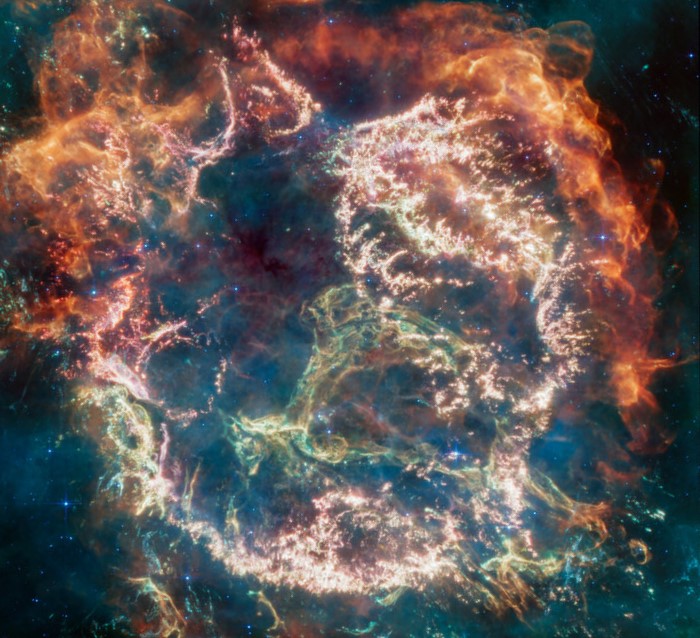
Some stars know how to make an exit. Here’s the newest image from the James Webb Space Telescope, released on April 7, 2023. It shows what’s called a supernova remnant – a giant expanding cloud of debris in space – which earthly astronomers call Cassiopeia A, or Cas A. This cloudy shroud is what remains of a massive star that exploded, from Earth’s perspective, some 340 years ago. Of course, for any Cassiopeians living near this star, which is 11,000 light-years from Earth, the event happened more than 11,000 years ago. While the supernova should have been bright enough for earthlings to see as a “new” star in the night sky in the 1690s, no one has yet found a record of anyone’s having witnessed it.
Located in the direction of the constellation Cassiopeia, Cas A is the brightest radio source in our sky, apart from our sun. Webb imaged the supernova remnant in the infrared, which is between visible and radio on the electromagnetic spectrum.
At 340 years old, Cas A is the 2nd-youngest supernova remnant we know in our Milky Way galaxy. The youngest is G1.9+0.3 – only 150 years old – located in the direction of the constellation Sagittarius.
Supernovas are key to life. When a star explodes, it releases the heavy elements made in its interior – including the building blocks of life, such as carbon, calcium and iron – into space. Elements such as these seeded life on Earth. And they have the potential to seed life on distant worlds, too.
Supernova remnant in infrared
In the image above, the bright orange regions show where material ejected from the explosion is smashing into interstellar gas and dust. The lighter, pinkish and somewhat circular region toward the interior are the remains of the star itself. These clumps and knots are a mix of heavy elements, including oxygen, argon and neon. The greenish loop is one region that scientists are still trying to understand.
One of the questions scientists are trying to answer is … where does cosmic dust come from? Even young galaxies in the early universe contain massive amounts of dust. While supernovas appear likely to be the answer, it doesn’t quite explain the amount of dust. As ESA said:
By studying Cas A with Webb, astronomers hope to gain a better understanding of its dust content, which can help inform our understanding of where the building blocks of planets and ourselves are created.
Bottom line: On April 7, 2023, ESA shared this new image from the James Webb Space Telescope of supernova remnant Cassiopeia A. Learn more about it here.
The post Supernova remnant Cas A is focus of new Webb image first appeared on EarthSky.
0 Commentaires